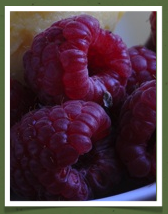Buy Red: A Closer Look at Anthocyanins
 Buy Red: A Closer Look at Anthocyanins
Buy Red: A Closer Look at Anthocyanins- Anthocyanins are water-soluble plant pigments in the flavinoid class of phytochemicals or plant chemicals.
- These healthful pigments can appear purple, red, blue, and almost black depending on their concentration and pH. They give eggplants, purple cabbage, purple grapes, cherries, strawberries and blackberries much of their reddish to almost black color. Eggplant skin has almost 750 mg of anthocyanin per 100 grams!
- Anthocyanins are also found in large amounts in blue or purple corn, purple potatoes, and black rice, olives, soybeans and sorghum.
- Smaller amounts of anthocyanins are found in red apples, asparagus, peas, and even bananas have some.
- Not all plants get their red to purplish coloring primarily from anthocyanins. Tomatoes get their red coloring mostly from lycopene. Beets get their purplish coloring largely from betalains. These other red to purple phytochemicals may also have health benefits but do not appear to impact blood lipids as the anthocyanins do.
“Fresh fruits, vegetables, legumes and whole grains contain more than just vitamins and minerals. The pigments they contain may help reduce the risk of many diseases.” -- Dr. James J Kenney, PhD, FACN
Anthocyanin content of common foods:
Fruits:
- Chokeberry: 2147
- Elderberry: 1993
- Black raspberry: 845
- Black currant: 533
- Blueberry: 529
- Marionberry: 433
- Blackberry: 353
- Acai berry: 300
- Concord grape: 192
- Cherry : 177
- Cranberry: 133
- Red raspberry: 116
- Black plum: 82
- Red grape: 42
- Strawberry: 35
- Red delicious apple: 17
- Nectarine/peach: 4-9
Vegetables/legumes/nuts/grains:
- Blue corn flour: 348
- Red radish: 116
- Red cabbage: 113
- Red onion: 38
- Red potatoes: 35
- Eggplant: 34
- Black beans: 23
- Purple potatoes: 17
- Small red beans: 6
- Pistachio: 2
- Red leaf lettuce: 1.5
Amounts are in mg/100g for total anthocyanin.Sources: J. Agric. Food Chem., Vol. 54, No. 11, 2006 4071, Journal of Agricultural and Food Chemistry 50 (21): 6182-6187, www.ars.usda.gov, Journal of Food Composition and Analysis Vol 21, Issue 4, June 2008: 291-99


